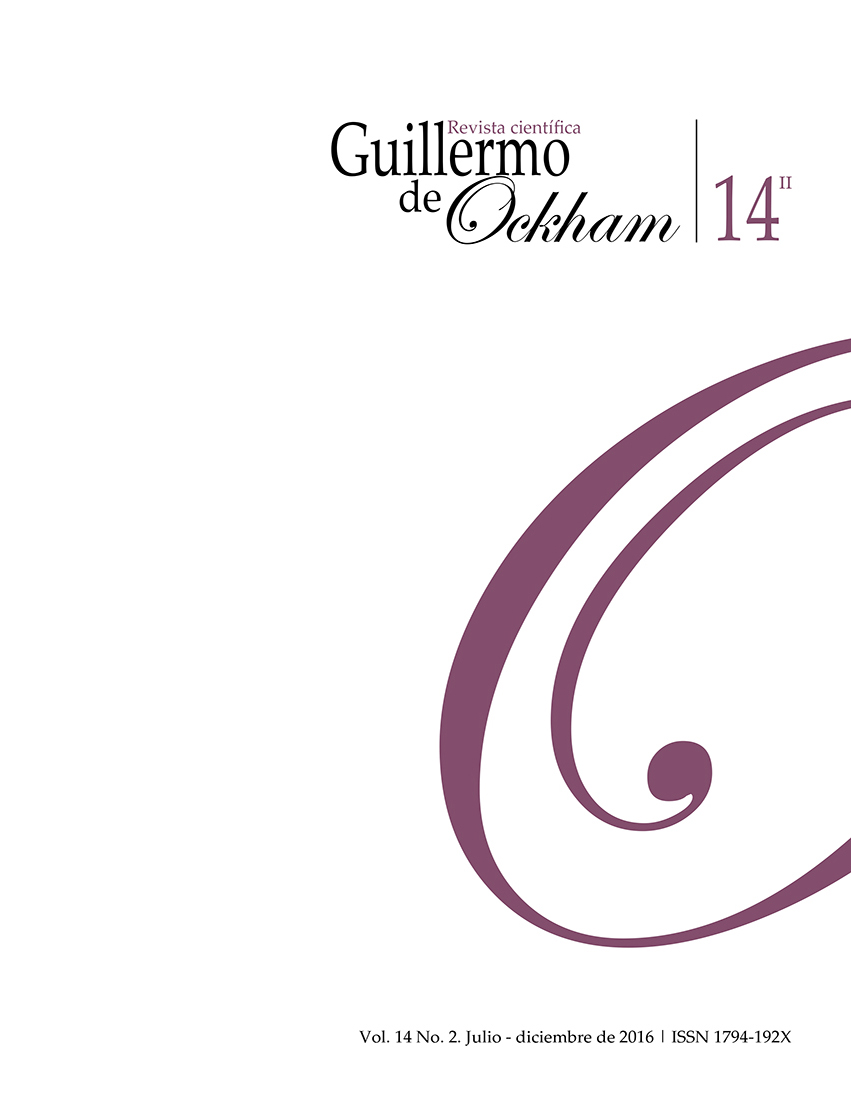The Revista Guillermo de Ockham provides an immediate and open access to its content, based on the principle of offering the public a free access to investigations to provide a global interchange of knowledge.
Unless otherwise established, the contents of this journal has a license with Creative Commons Attribution-NonCommercial-NoDerivatives 4.0 International (CC BY-NC-ND 4.0) http://creativecommons.org/licenses/by-nc-nd/4.0/
- Attribution: You must give appropriate credit, provide a link to the license, and indicate if changes were made. You may do so in any reasonable manner, but not in any way that suggests the licensor endorses you or your use.
- NonCommercial: You may not use the material for commercial purposes.
- NoDerivatives: If you remix, transform, or build upon the material, you may not distribute the modified material.
- No additional restrictions: You may not apply legal terms or technological measures that legally restrict others from doing anything the license permits.
Resumo
La filosofía de la información ha experimentado un enorme auge en los últimos años, consolidándose como un ámbito de indagación filosófica autónomo. Su tema de estudio, el concepto de información, es uno de los términos más comunes y extendidos en nuestros días, abarcando ámbitos tan disímiles como el lenguaje cotidiano y la mecánica cuántica. Esta presencia ubicua y universal del término es lo que conduce a que su análisis y abordaje filosófico sea una empresa sumamente compleja y desafiante. El presente artículo pretende ofrecer algunas líneas generales que permitan distinguir diferentes tipos de información, diferentes enfoques, diferentes contextos donde el concepto es utilizado y diferentes interpretaciones. De esta manera, se muestra que la filosofía de la información es un ámbito sumamente diverso y plural, donde el concepto de información tiene tantos significados, como usos y contextos.
Referências
Adriaans, P. and van Benthem, J. (2008). Handbook of Philosophy of Information. Amsterdam, Oxford: Elsevier.
Bar-Hillel, Y. (1964). Language and Information: Selected Essays on Their Theory and Application. Reading, Mass: Addison-Wesley.
Bar-Hillel, Y. and Carnap, R. (1953). “Semantic Information.” The British Journal for the Philosophy of Science, 4:147-57.
Barwise, J. and Seligman, J. (1997). Information Flow: The Logic of Distributed Systems. Cambridge: Cambridge University Press.
Bell, David (1957). Information Theory and its Engineering Applications. London: Pitman & Sons.
Bergstrom, C. y Rosvall, M. (2011). “The transmission sense of information”. Biology & Philosophy, 26: 159-176.
Burnham, K. y Anderson, D. (1998). Model selection and multimodel inference: a practical information-theoretic approach. New York: Springer.
Chaitin, G. (1966). “On the Length of Programs for Computing Binary Sequences.” Journal of the Association for Computing Machinery, 13: 547-569.
Cover, T. and Thomas, J. (1991). Elements of Information Theory. New York: John Wiley & Sons.
Davies, P. (2014). “Universe from bit”. En Information and the Nature of Reality, Paul Davies y Niels Gregersen (eds), Cambridge: Cambridge University Press, 65-91.
Devlin, K. J. (1991). Logic and Information. Cambridge: Cambridge University Press.
Dretske, F. (1981). Knowledge & the Flow of Information. Cambridge MA: MIT Press.Dodig-Crnkovi 2005
Duwell, A. (2008). “Quantum Information Does Exist.” Studies in History and Philosophy of Modern Physics, 39: 195-216.
Fetzer, J. H. (1990), Artificial Intelligence: Its Scope and Limits, Dordrecht, The Netherlands: Kluwer Academic Publishers.
Fetzer, J. H. (2004). “Information: Does It Have to Be True?” Minds and Machines, 14(2): 223–229.
Fisher, R. (1925). “Theory of Statistical Estimation.” Proceedings of the Cambridge Philosophical Society, 22: 700-725.
Floridi, L. (2003). “Two Approaches to the Philosophy of Information”. Minds and Machines, 13(4): 459–469.
Floridi, L. (2015). The Ethics of Information. Oxford: Oxford University Press
Floridi, L. (2016). "Semantic Conceptions of Information". En The Stanford Encyclopedia of Philosophy, Edward N. Zalta (ed.), URL =
Godfrey-Smith, P. y Sterelny, K. (2016). “Biological Information”. Em The Stanford Encyclopedia of Philosophy, Edward N. Zalta (ed.), URL =
Jozsa, R. (1998). “Quantum information and its properties”. En Introduction to Quantum Computation and Information, H.-K. Lo, S. Popescu, y T. Spiller (eds.) Singapore: World Scientific, pp. 49-75.
Kolmogorov, A. (1965). “Three Approaches to the Quantitative Definition of Information.” Problems of Information Transmission, 1: 4-7
Kolmogorov, A. (1968). “Logical Basis for Information Theory and Probability Theory.” Transactions on Information Theory, 14: 662-664.
Landauer, R. (1991). “Information is Physical.” Physics Today, 44: 23-29.
Landauer, R. (1996). “The Physical Nature of Information.” Physics Letters A, 217: 188-193.
Lloyd, S. (2014). “The computational universe”. En Information and the Nature of Reality, Paul Davies y Niels Gregersen (eds), Cambridge: Cambridge University Press, 92-103.
Lombardi, O. (2005). “Dretske, Shannon’s Theory and the Interpretation of Information.” Synthese, 144: 23-39
MacKay, D. (1969). Information, Mechanism and Meaning. Cambridge MA: MIT Press.
Lombardi, O., Holik, F. and Vanni, L. (2014). “What Is Quantum Information?”, PhilSci Archive, #11159.
Nauta, D. (1972). The Meaning of Information. The Hague: Mouton.
Nielsen, M. and Chuang, I. (2010). Quantum Computation and Quantum Information. Cambridge: Cambridge University Press.
Reza, F. (1961). Introduction to Information Theory. New York: McGraw-Hill
Rovelli, C. (1996). “Relational Quantum Mechanics.” International Journal of Theoretical Physics, 35: 1637-1678.
Schumacher, B. (1995). “Quantum coding”. Physical Review A, 51: 2738-2747.
Shannon, C. (1948). “The mathematical theory of communication”. Bell System Technical Journal, 27: 379-423.
Solomonoff, R. (1964). “A Formal Theory of Inductive Inference.” Information and Control, 7: 1-22, 224-254.
Stonier, T. (1990). Information and the Internal Structure of the Universe: An Exploration into Information Physics. New York-London: Springer.
Stonier, T. (1996). “Information as a Basic Property of the Universe.” Biosystems, 38: 135-140.
Timpson, C. (2004). Quantum Information Theory and the Foundations of Quantum Mechanics. PhD diss., University of Oxford (quant-ph/0412063).
Timpson, C. (2008). “Philosophical Aspects of Quantum Information Theory.” En The Ashgate Companion to the New Philosophy of Physics, Dean Rickles (ed.),. Aldershot: Ashgate Publishing, pp. 197-261
Timpson, C. (2013). Quantum Information Theory and the Foundations of Quantum Mechanics. Oxford: Oxford University Press.
Wheeler , J. A. ( 1989 ). “Information, physics, quantum: The search for links” . Proceedings of the Third International Symposium on the Foundations of Quantum Mechanics (Tokyo), 354.
Wittgenstein, L. (1981). Zettel. Oxford: Blackwell.
Zeilinger, A. (1999). “A Foundational Principle for Quantum Mechanics.” Foundations of Physics, 29: 631-643.































